商户查询缓存
01.什么是缓存
缓存就是数据交换的缓冲区(称作Cache),是存贮数据的临时地方,一般读写性能较高。
- 浏览器缓存。
- 应用层缓存。
- 数据库缓存。
- CPU缓存。
- 磁盘缓存。
缓存的作用
- 降低后端负载。
- 提高读写效率,降低响应时间。
缓存的成本
- 数据一致性成本。
- 代码维护成本。
- 运维成本。
02.添加商户缓存
缓存作用模型
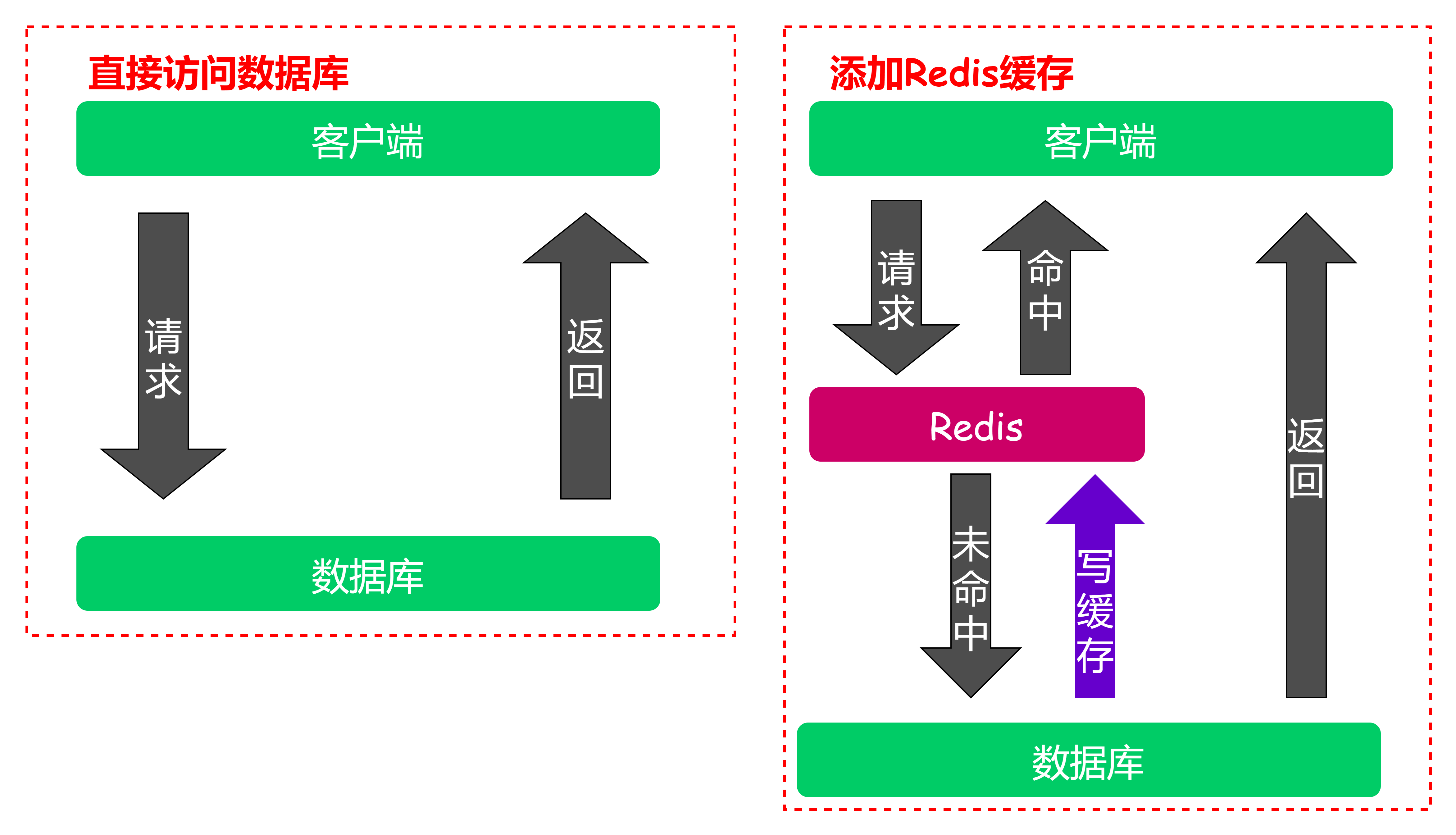
根据id查询商铺缓存的流程
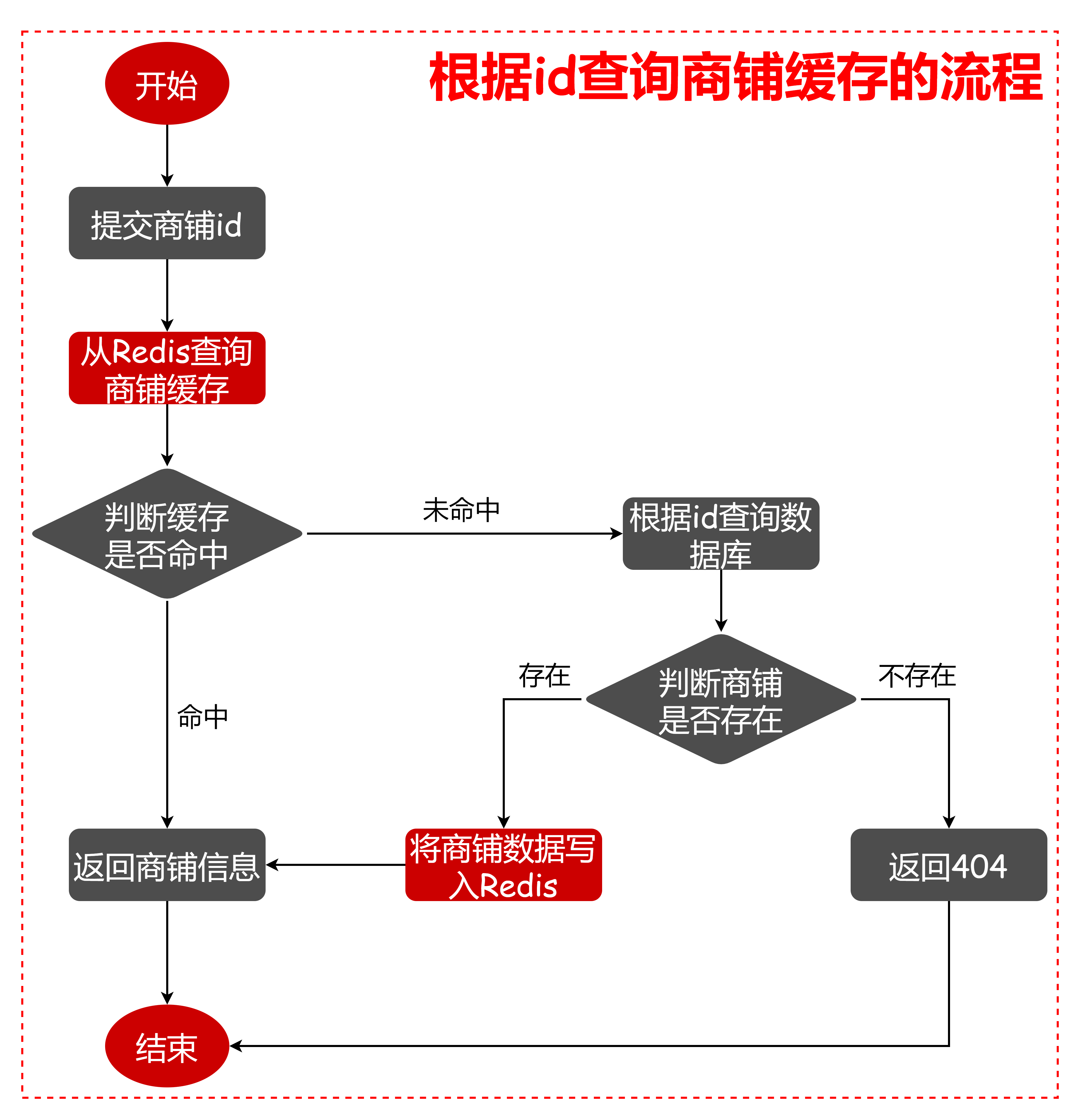
添加商铺查询缓存
ShopServiceImpl:Redis的value使用String。
@Override
public Result queryShopById(Long id) {
Shop shop;
// 1.Redis查询商铺缓存
String shopKey = RedisConstants.CACHE_SHOP_KEY + id;
String shopJson = stringRedisTemplate.opsForValue().get(shopKey);
if (ObjectUtil.isNotEmpty(shopJson)){
shop = JSONUtil.toBean(shopJson, Shop.class);
return Result.ok(shop);
}
// 2.缓存未命中: 查询数据库
shop = getById(id);
if (ObjectUtil.isEmpty(shop)){
return Result.fail("店铺不存在!");
}
// 3.商铺数据写入Redis
stringRedisTemplate.opsForValue().set(shopKey, JSONUtil.toJsonStr(shop));
// 4.返回商铺信息
return Result.ok(shop);
}
添加店铺类型查询缓存
ShopTypeServiceImpl:Redis的value使用Set。
@Override
public Result queryTypeList() {
Set<ShopType> shopTypeSet;
// 1.Redis查询店铺类型
String shopTypeKey = RedisConstants.CACHE_SHOP_TYPE_KEY;
Set<String> shopTypeJson = stringRedisTemplate.opsForSet().members(shopTypeKey);
if (Objects.nonNull(shopTypeJson) && !shopTypeJson.isEmpty()){
shopTypeSet = shopTypeJson.stream()
.map(st -> JSONUtil.toBean(st, ShopType.class))
.collect(Collectors.toSet());
return Result.ok(shopTypeSet);
}
// 2.缓存未命中,查询数据库
List<ShopType> shopTypes = query().orderByAsc("sort").list();
shopTypeSet = new HashSet<>(shopTypes);
if (ObjectUtil.isEmpty(shopTypeSet) || shopTypeSet.isEmpty()){
return Result.fail("店铺类型无数据");
}
// 3.店铺类型数据写入缓存
for (ShopType shopType : shopTypeSet) {
stringRedisTemplate.opsForSet().add(shopTypeKey, JSONUtil.toJsonStr(shopType));
}
// 4.返回店铺类型数据
return Result.ok(shopTypeSet);
}
03.缓存更新策略
策略选择
| 内存淘汰 | 超时剔除 | 主动更新 | |
|---|---|---|---|
| 说明 | 不用自己维护,利用Redis的内存淘汰机制。当内存不足时,自动淘汰部分数据,下次查询时更新缓存。 | 给缓存数据添加TTL时间,到期后自动删除缓存,下次查询时更新缓存。 | 编写业务逻辑,在修改数据库的同时,更新缓存。 |
| 一致性 | 差 | 一般 | 好 |
| 维护成本 | 无 | 低 | 高 |
业务场景:
- 低一致性需求:使用内存淘汰机制。例如店铺类型的查询缓存。
- 高一致性需求:主动更新,并以超时剔除作为
兜底方案。例如店铺详情查询的缓存。
主动更新
- Cache Aside Pattern:由缓存的调用者,在更新数据库的同时更新缓存。
- Read/Write Through Pattern:缓存与数据库整合为一个服务,由服务来维护一致性。调用者调用该服务,无需关心缓存一致性问题。
- Write Behind Caching Pattern:调用者只操作缓存,由其它线程异步的将缓存数据持久化到数据库,保证最终一致。
最后选择的是Cache Aside Pattern,因为这可以保持数据库和缓存的数据一致性。
主动更新策略Cache Aside Pattern,操作缓存和数据库时有三个问题需要考虑:
删除缓存还是更新缓存?
- 更新缓存:每次更新数据库都更新缓存,无效写操作较多。
- 删除缓存:更新数据库时让缓存失效,查询时再更新缓存。
如何保证缓存与数据库的操作的同时成功或失败?
- 单体系统,将缓存与数据库操作放在一个事务。
- 分布式系统,利用TCC等分布式事务方案。
先操作缓存还是先操作数据库?
- 先删除缓存,再操作数据库。
- 先操作数据库,再删除缓存。
最佳实践
- 低一致性需求:使用Redis自带的内存淘汰机制。
- 高一致性需求:主动更新,并以超时剔除作为兜底方案。
- 读操作:缓存命中则直接返回。缓存未命中则查询数据库,并写入缓存,设定超时时间。
- 写操作:先写数据库,然后再删除缓存。要确保数据库与缓存操作的原子性。
04.商铺缓存和数据库的双写一致
商铺存入redis添加过期时间:
ShopServiceImpl
@Override
public Result queryShopById(Long id) {
Shop shop;
// 1.Redis查询商铺缓存
String shopKey = RedisConstants.CACHE_SHOP_KEY + id;
String shopJson = stringRedisTemplate.opsForValue().get(shopKey);
if (ObjectUtil.isNotEmpty(shopJson)){
shop = JSONUtil.toBean(shopJson, Shop.class);
return Result.ok(shop);
}
// 2.缓存未命中: 查询数据库
shop = getById(id);
if (ObjectUtil.isEmpty(shop)){
return Result.fail("店铺不存在!");
}
// 3.商铺数据写入Redis: 添加过期时间
stringRedisTemplate.opsForValue().set(shopKey, JSONUtil.toJsonStr(shop), RedisConstants.CACHE_SHOP_TTL, TimeUnit.MINUTES);
// 4.返回商铺信息
return Result.ok(shop);
}
ShopController
@PutMapping
public Result updateShop(@RequestBody Shop shop) {
if (null == shop.getId()){
return Result.fail("店铺id不能为空!");
}
return shopService.updateShop(shop);
}
ShopServiceImpl
@Override
@Transactional(rollbackFor = Exception.class)
public Result updateShop(Shop shop) {
// 1.更新数据库
updateById(shop);
// 2.删除缓存
stringRedisTemplate.delete(RedisConstants.CACHE_SHOP_KEY + shop.getId());
return Result.ok();
}
05.缓存穿透问题及解决思路
缓存穿透是指客户端请求的数据在缓存中和数据库中都不存在,这样缓存永远不会生效,这些请求都会打到数据库。
常见的解决方案有两种:
- 缓存空对象:
- 优点:实现简单,维护方便。
- 缺点:额外的内存消耗,可能造成短期的不一致。
- 布隆过滤:
- 优点:内存占用较少,没有多余key。
- 缺点:实现复杂,存在误判可能。
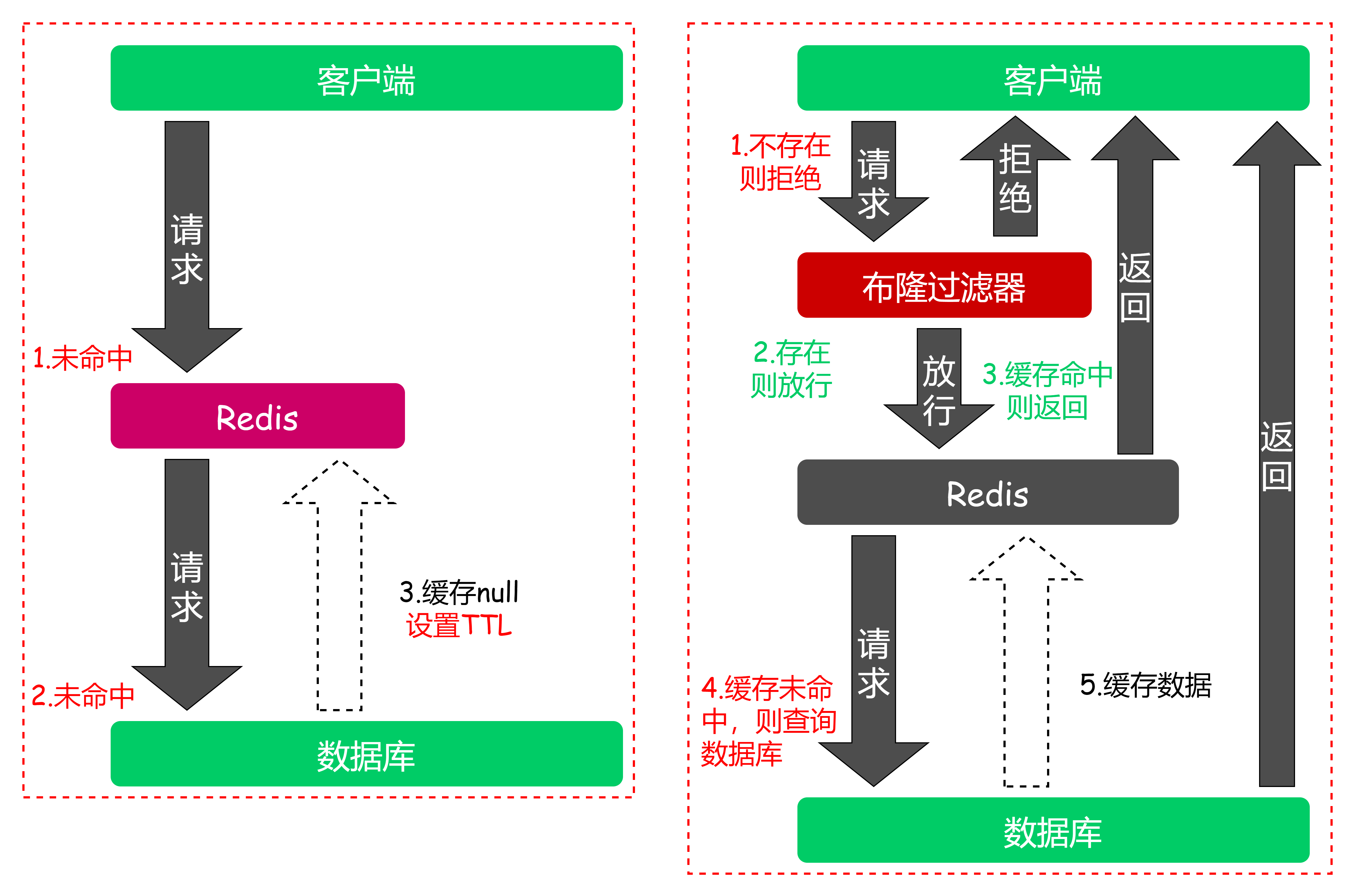
缓存穿透产生的原因是什么?
用户请求的数据在缓存中和数据库中都不存在,不断发起这样的请求,给数据库带来巨大压力
缓存穿透的解决方案有哪些?
- 缓存null值。
- 布隆过滤。
- 增强id的复杂度,避免被猜测id规律。
- 做好数据的基础格式校验。
- 加强用户权限校验。
- 做好热点参数的限流。
06.解决商铺查询缓存穿透
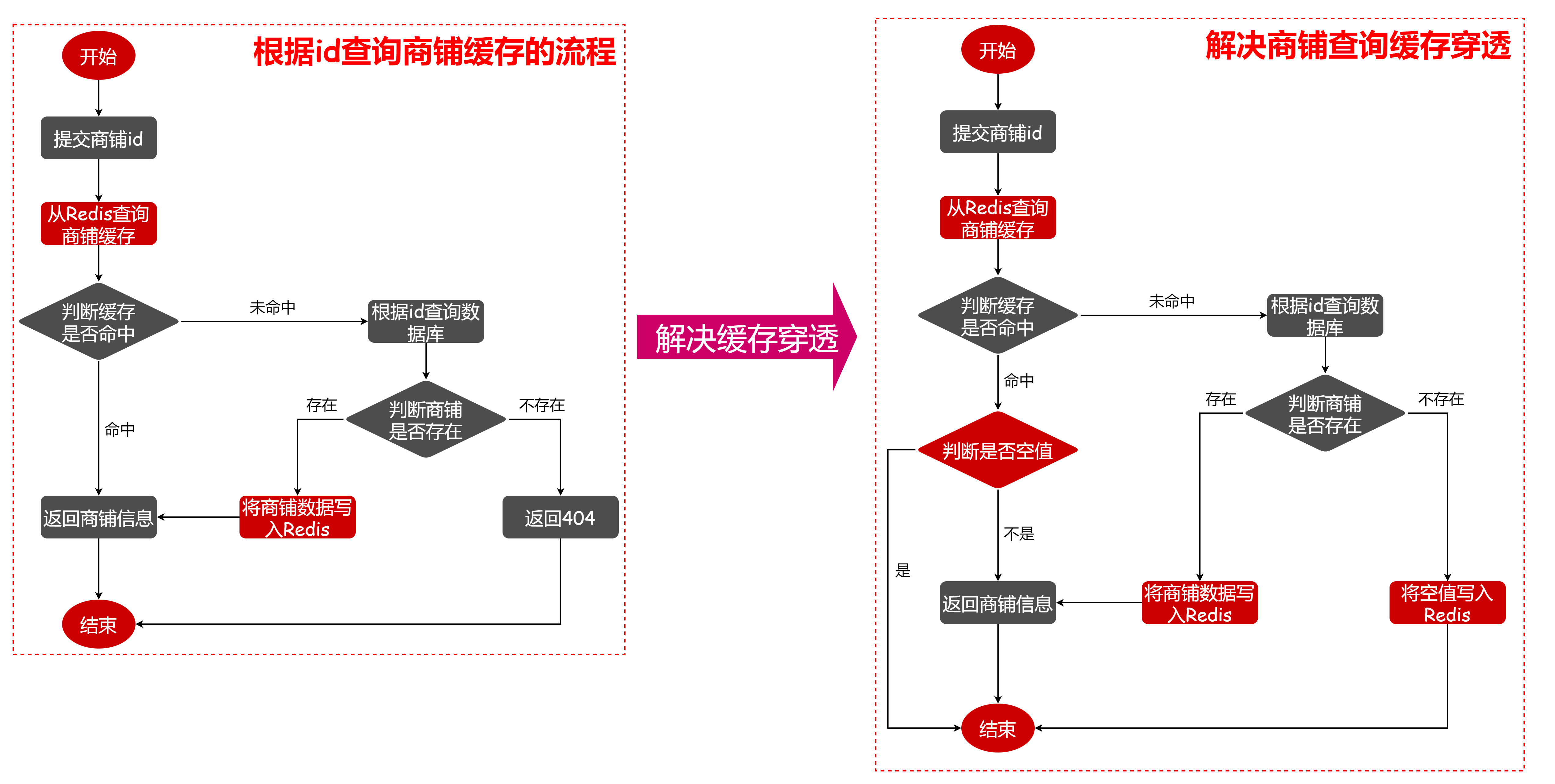
ShopServiceImpl:缓存穿透解决方案是缓存null值。
@Override
public Result queryShopById(Long id) {
Shop shop;
// 1.Redis查询商铺缓存
String shopKey = RedisConstants.CACHE_SHOP_KEY + id;
String shopJson = stringRedisTemplate.opsForValue().get(shopKey);
if (StrUtil.isNotBlank(shopJson)){
shop = JSONUtil.toBean(shopJson, Shop.class);
return Result.ok(shop);
}
// 命中是否为空值
if (Objects.nonNull(shopJson)){
return Result.fail("店铺不存在!");
}
// 2.缓存未命中: 查询数据库
shop = getById(id);
if (ObjectUtil.isEmpty(shop)){
// 将空值写入Redis
stringRedisTemplate.opsForValue().set(shopKey, "", RedisConstants.CACHE_NULL_TTL, TimeUnit.MINUTES);
return Result.fail("店铺不存在!");
}
// 3.商铺数据写入Redis
stringRedisTemplate.opsForValue().set(shopKey, JSONUtil.toJsonStr(shop), RedisConstants.CACHE_SHOP_TTL, TimeUnit.MINUTES);
// 4.返回商铺信息
return Result.ok(shop);
}
07.缓存雪崩问题及解决思路
缓存雪崩是指在同一时段大量的缓存key同时失效或者Redis服务宕机,导致大量请求到达数据库,带来巨大压力。
解决方案
- 给不同的Key的TTL添加随机值。
- 利用Redis集群提高服务的可用性。
- 给缓存业务添加降级限流策略。
- 给业务添加多级缓存。
08.缓存击穿问题及解决思路
缓存击穿问题也叫热点Key问题,就是一个被高并发访问并且缓存重建业务较复杂的key突然失效了,无数的请求访问会在瞬间给数据库带来巨大的冲击。
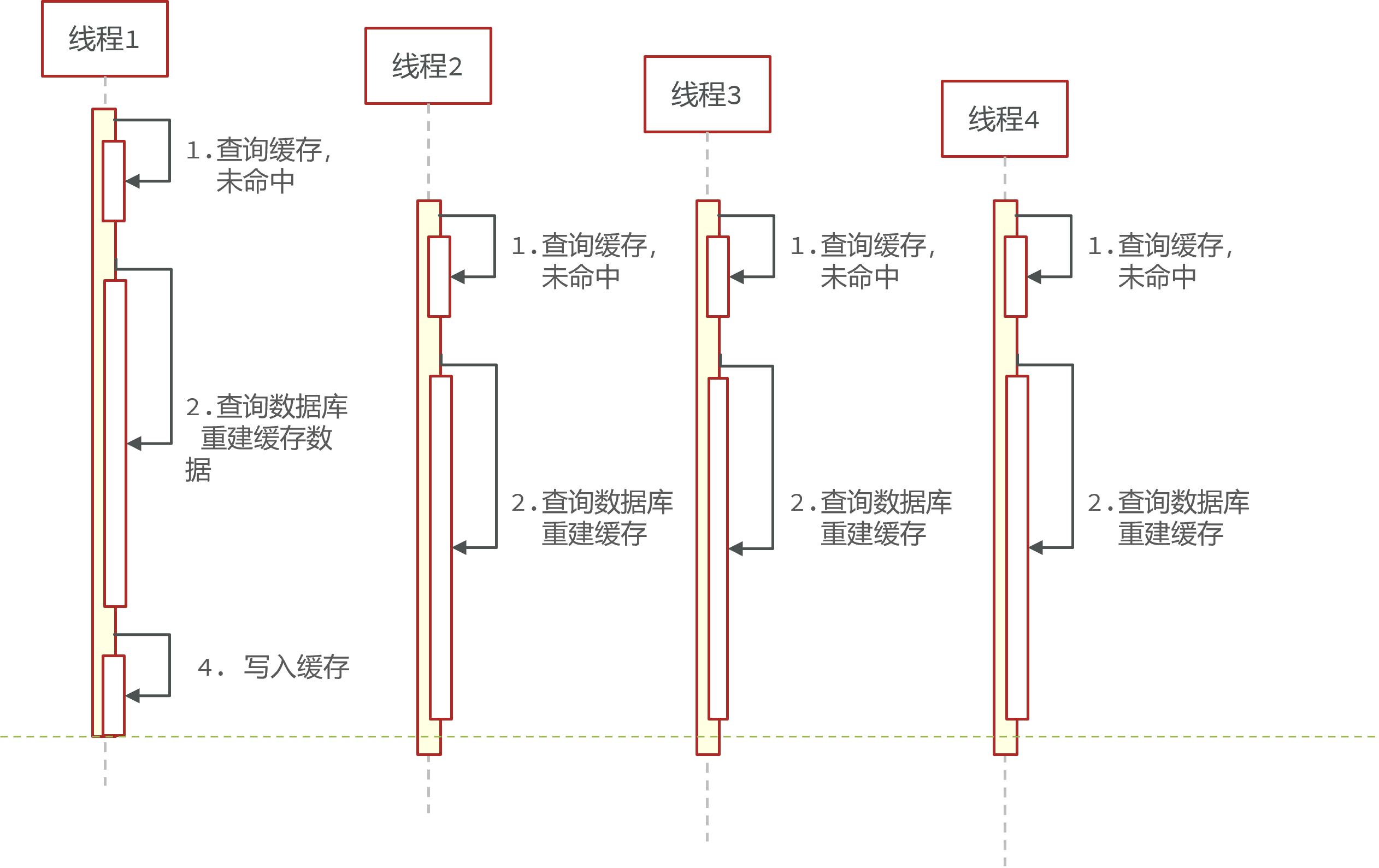
常见的解决方案有两种:
互斥锁。
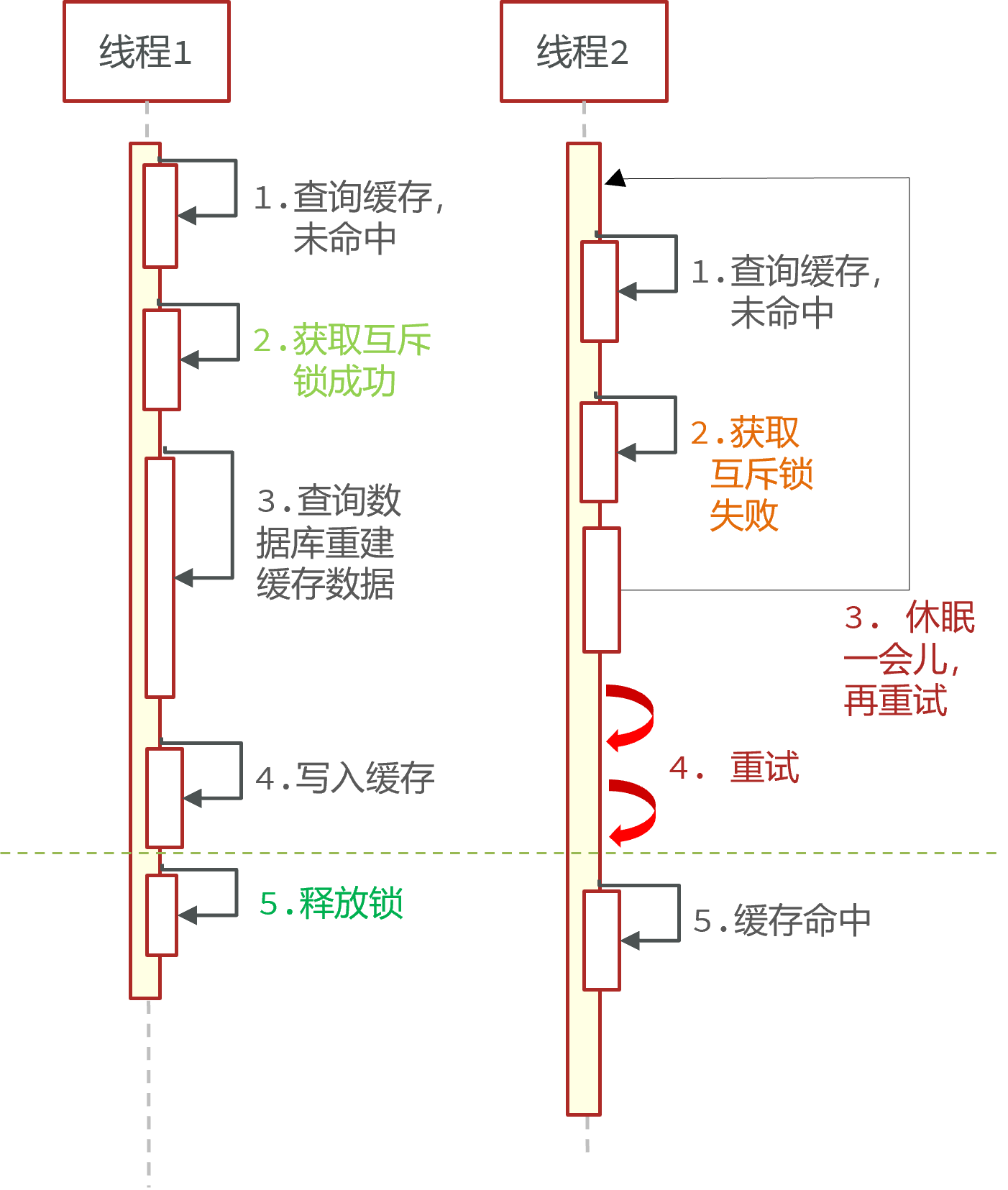
image-20230131115725079 逻辑过期。
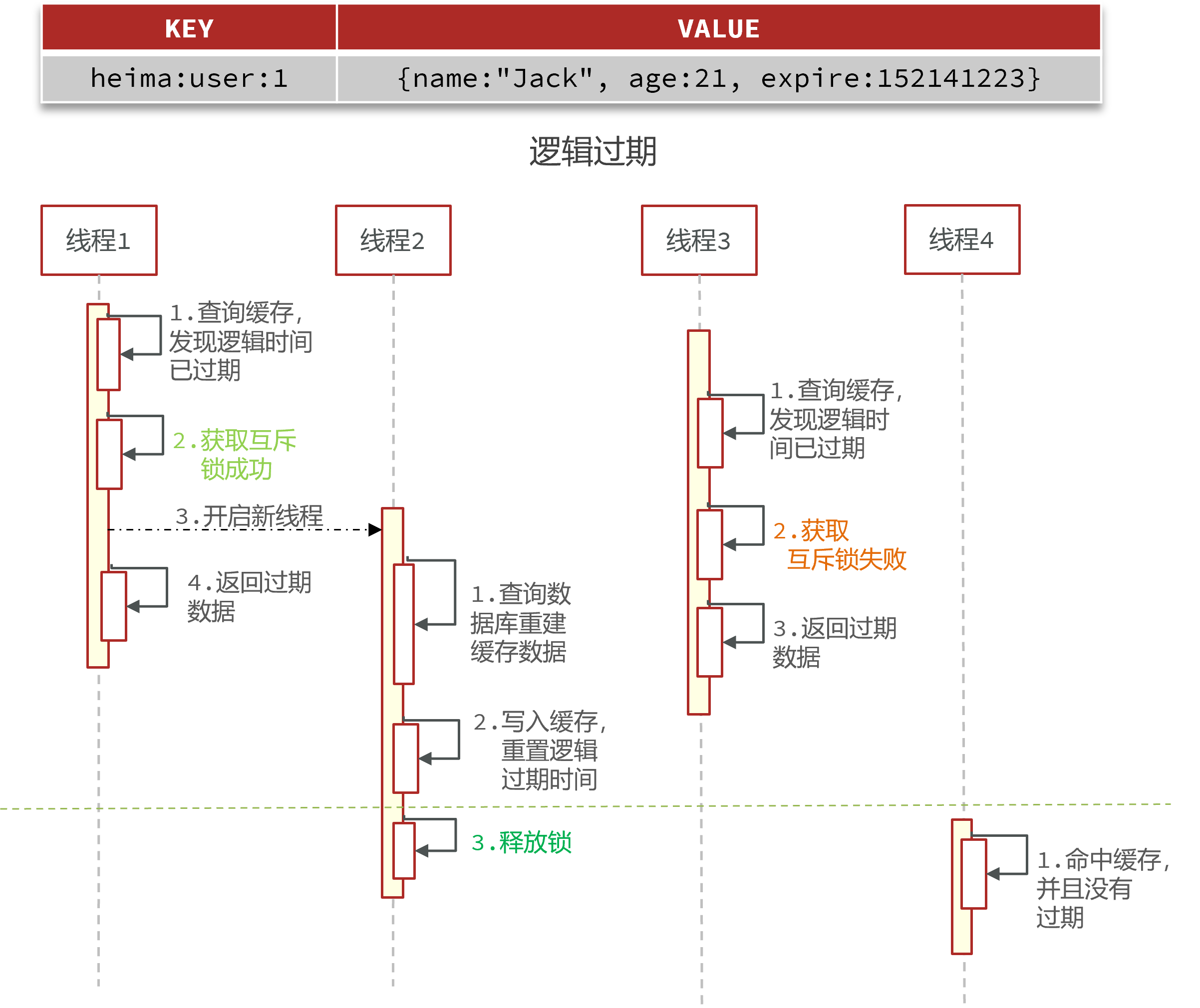
image-20230131115944992
| 解决方案 | 优点 | 缺点 |
|---|---|---|
| 互斥锁 | 没有额外的内存消耗 保证一致性 实现简单 | 线程需要等待,性能受影响 可能有死锁风险 |
| 逻辑过期 | 线程无需等待,性能较好 | 不保证一致性 有额外内存消耗 实现复杂 |
09.利用互斥锁解决缓存击穿问题
互斥锁解决商铺查询
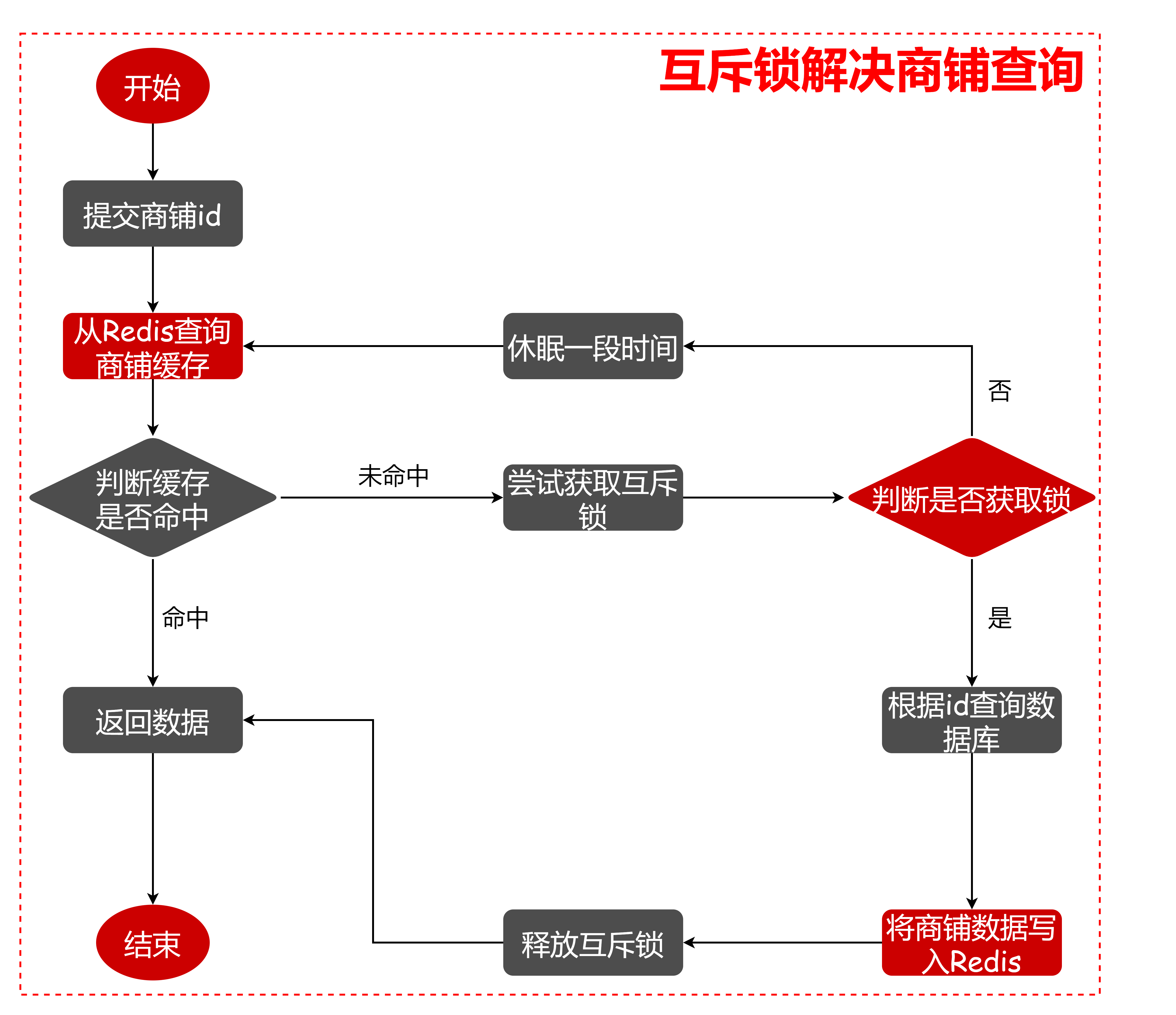
ShopServiceImpl
@Override
public Result queryShopById(Long id) {
Shop shop = queryWithMutex(id);
if (Objects.isNull(shop)){
return Result.fail("店铺不存在");
}
return Result.ok(shop);
}
/**
* 解决商铺查询缓存击穿: 互斥锁
* @param id 商铺id
* @return 商铺信息
*/
private Shop queryWithMutex(Long id) {
Shop shop = null;
// 1.Redis查询商铺缓存
String shopKey = RedisConstants.CACHE_SHOP_KEY + id;
String shopJson = stringRedisTemplate.opsForValue().get(shopKey);
if (StrUtil.isNotBlank(shopJson)){
shop = JSONUtil.toBean(shopJson, Shop.class);
return shop;
}
// 命中是否为空值
if (RedisConstants.CACHE_NULL_VALUE.equals(shopJson)){
return null;
}
// 2.实现缓存重建
// 2.1 获取互斥锁
String lockKey = RedisConstants.LOCK_SHOP_KEY + id;
try {
boolean isLock = tryLock(lockKey);
// 2.2判断是否获取成功
if (!isLock){
// 2.3 获取锁失败,休眠并重试
Thread.sleep(50);
return queryWithMutex(id);
}
// 2.4.1 获取锁成功,查询缓存
shopJson = stringRedisTemplate.opsForValue().get(shopKey);
if (StrUtil.isNotBlank(shopJson)){
shop = JSONUtil.toBean(shopJson, Shop.class);
return shop;
}
// 命中是否为空值
if (RedisConstants.CACHE_NULL_VALUE.equals(shopJson)){
return null;
}
// 2.4.2 获取锁成功,查询数据库
shop = getById(id);
// 模拟重建的延时
Thread.sleep(200);
if (ObjectUtil.isEmpty(shop)){
// 将空值写入Redis
stringRedisTemplate.opsForValue().set(shopKey, RedisConstants.CACHE_NULL_VALUE, RedisConstants.CACHE_NULL_TTL, TimeUnit.MINUTES);
return null;
}
// 3.商铺数据写入Redis
stringRedisTemplate.opsForValue().set(shopKey, JSONUtil.toJsonStr(shop), RedisConstants.CACHE_SHOP_TTL, TimeUnit.MINUTES);
} catch (InterruptedException e) {
throw new RuntimeException();
} finally {
// 4.释放互斥锁
unlock(lockKey);
}
// 5.返回商铺信息
return shop;
}
互斥锁的获取和释放
/**
* 获取互斥锁
* @param key key
* @return boolean
*/
private boolean tryLock(String key){
Boolean flag = stringRedisTemplate.opsForValue().setIfAbsent(key, "1", RedisConstants.LOCK_SHOP_TTL, TimeUnit.SECONDS);
return BooleanUtil.isTrue(flag);
}
/**
* 释放互斥锁
* @param key key
*/
private void unlock(String key){
stringRedisTemplate.delete(key);
}
10.利用逻辑过期解决缓存击穿问题
需求:修改根据id查询商铺的业务,基于逻辑过期方式来解决缓存击穿问题。
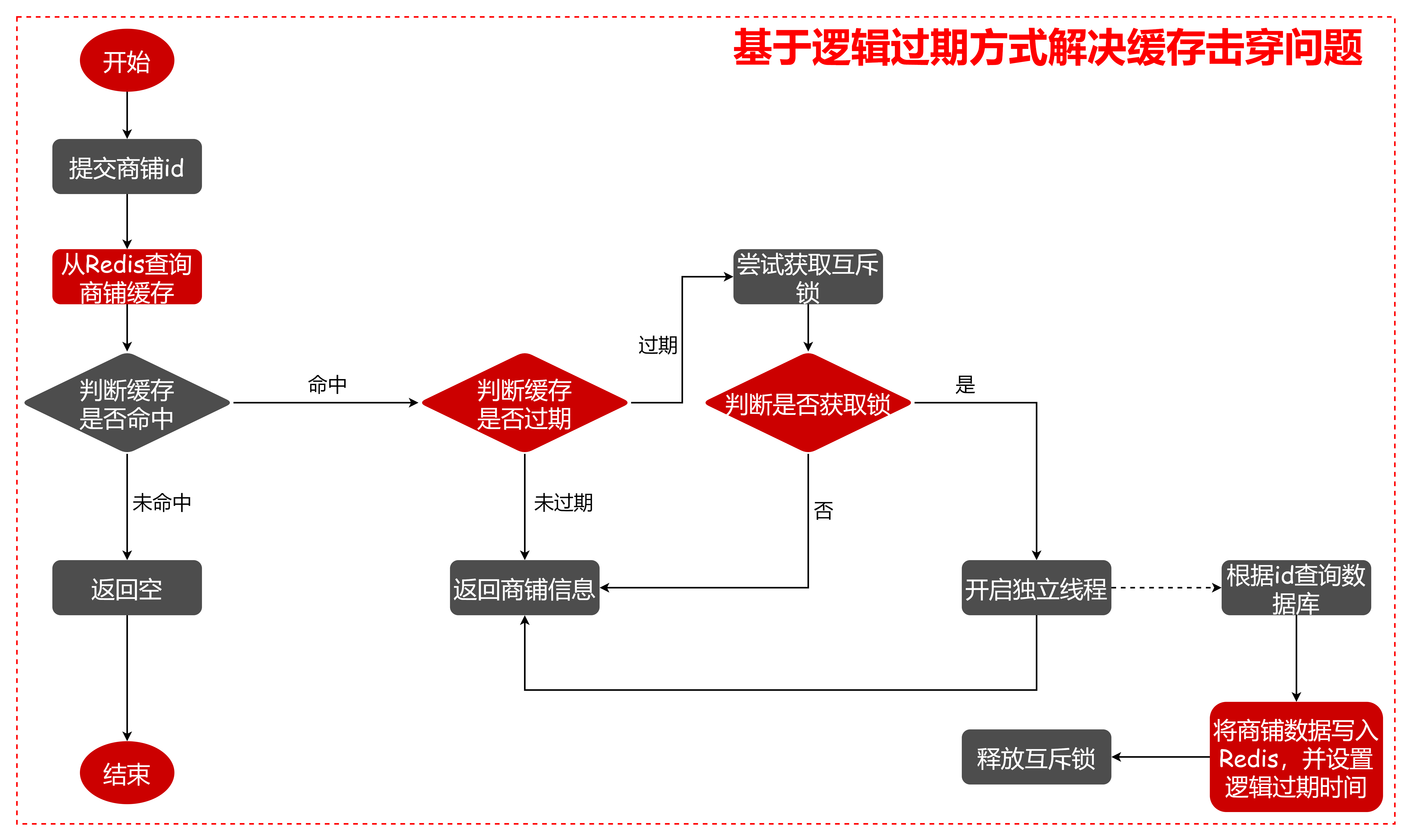
private static final ExecutorService CACHE_REBUILD_EXECUTOR = new ThreadPoolExecutor(
10,
15,
20, TimeUnit.SECONDS,
new LinkedBlockingQueue<>(),
ThreadFactoryBuilder.create().build(),
new ThreadPoolExecutor.AbortPolicy());
private Shop queryWithLogicExpire(Long id) {
// 1.Redis查询商铺缓存
String shopKey = RedisConstants.CACHE_SHOP_KEY + id;
String shopJson = stringRedisTemplate.opsForValue().get(shopKey);
// 1.1 缓存未命中
if (StrUtil.isBlank(shopJson)){
// 直接返回null
return null;
}
// 2.命中: json反序列化
RedisData redisData = JSONUtil.toBean(shopJson, RedisData.class);
Shop shop = JSONUtil.toBean((JSONObject) redisData.getData(), Shop.class);
LocalDateTime expireTime = redisData.getExpireTime();
// 3.判断是否过期
if (expireTime.isAfter(LocalDateTime.now())){
// 3.1 未过期,直接返回店铺信息
return shop;
}
// 3.2 已过期,需要缓存重建
// 4.缓存重建
// 4.1 获取互斥锁
String lockKey = RedisConstants.LOCK_SHOP_KEY + id;
boolean isLock = tryLock(lockKey);
// 4.2 判断是否获取锁成功
if (isLock){
// 4.3 成功,开启独立线程,实现缓存重建
// 4.3.1 再次查询缓存,命中直接返回
shopJson = stringRedisTemplate.opsForValue().get(shopKey);
if (StrUtil.isNotBlank(shopJson)){
redisData = JSONUtil.toBean(shopJson, RedisData.class);
shop = JSONUtil.toBean((JSONObject) redisData.getData(), Shop.class);
expireTime = redisData.getExpireTime();
// 3.判断是否过期
if (expireTime.isAfter(LocalDateTime.now())){
// 3.1 未过期,直接返回店铺信息
return shop;
}
}
// 4.3.2 未命中,缓存重建
CACHE_REBUILD_EXECUTOR.submit(() -> {
try {
this.saveShop2Redis(id, 20L);
} catch (Exception e) {
throw new RuntimeException(e);
} finally {
// 释放锁
unlock(lockKey);
}
});
}
return shop;
}
public void saveShop2Redis(Long id, Long expireSeconds) throws InterruptedException {
// 1.查询店铺数据
Shop shop = getById(id);
Thread.sleep(200);
// 2.封装逻辑过期时间
RedisData redisData = new RedisData();
redisData.setData(shop);
redisData.setExpireTime(LocalDateTime.now().plusSeconds(expireSeconds));
// 存入Redis
stringRedisTemplate.opsForValue().set(RedisConstants.CACHE_SHOP_KEY + id, JSONUtil.toJsonStr(redisData));
}
11.封装Redis工具类
基于StringRedisTemplate封装一个缓存工具类,满足下列需求:
方法1:将任意Java对象序列化为json并存储在string类型的key中,并且可以设置TTL过期时间。
/** * 往Redis存储数据,并设置过期时间 * @param key 存储key * @param object 存储value * @param time 过期时间 * @param unit 时间单位 */ public void set(String key, Object object, Long time, TimeUnit unit){ stringRedisTemplate.opsForValue().set(key, JSONUtil.toJsonStr(object), time, unit); }方法2:将任意Java对象序列化为json并存储在string类型的key中,并且可以设置逻辑过期时间,用于处理缓存击穿问题。
/** * 往Redis存储数据,并设置逻辑过期 * @param key 存储key * @param object 存储value * @param time 逻辑过期时间 * @param unit 时间单位 */ public void setWithLogicExpire(String key, Object object, Long time, TimeUnit unit){ RedisData redisData = new RedisData(); redisData.setData(object); redisData.setExpireTime(LocalDateTime.now().plusSeconds(unit.toSeconds(time))); stringRedisTemplate.opsForValue().set(key, JSONUtil.toJsonStr(redisData)); }方法3:根据指定的key查询缓存,并反序列化为指定类型,利用缓存空值的方式解决缓存穿透问题。
/** * 解决查询缓存穿透: 缓存null值 * @param keyPrefix key前缀 * @param id 对象id * @param type 对象Class * @param dbFallback 数据库查询语句 * @param time 过期时间 * @param unit 时间单位 * @param <R> 返回类型 * @param <T> id类型 * @return R */ public <R, T> R queryWithPassThrough(String keyPrefix, T id, Class<R> type, Function<T, R> dbFallback, Long time, TimeUnit unit) { String key = keyPrefix + id; String json = stringRedisTemplate.opsForValue().get(key); if (StrUtil.isNotBlank(json)){ return JSONUtil.toBean(json, type); } // 缓存命中空值 if (Objects.nonNull(json)){ return null; } R r = dbFallback.apply(id); if (ObjectUtil.isEmpty(r)){ this.set(key, RedisConstants.CACHE_NULL_VALUE, RedisConstants.CACHE_NULL_TTL, TimeUnit.MINUTES); return null; } this.set(key, r, time, unit); return r; }方法4:根据指定的key查询缓存,并反序列化为指定类型,需要利用逻辑过期解决缓存击穿问题。
/** * 逻辑过期解决缓存穿透查询 * @param keyPrefix key前缀 * @param id 对象id * @param type 对象类型 * @param dbFallback 数据查询语句 * @param time 逻辑过期时间 * @param unit 时间单位 * @param <R> 返回类型 * @param <T> id类型 * @return R */ public <R, T> R queryWithLogicExpire(String keyPrefix, T id, Class<R> type, Function<T, R> dbFallback, Long time, TimeUnit unit) { String key = keyPrefix + id; String json = stringRedisTemplate.opsForValue().get(key); if (StrUtil.isBlank(json)){ return null; } RedisData redisData = JSONUtil.toBean(json, RedisData.class); R r = JSONUtil.toBean((JSONObject) redisData.getData(), type); LocalDateTime expireTime = redisData.getExpireTime(); if (expireTime.isAfter(LocalDateTime.now())){ return r; } String lockKey = RedisConstants.LOCK_SHOP_KEY + id; boolean isLock = tryLock(lockKey); if (isLock){ // 获取锁之后再次查询缓存 json = stringRedisTemplate.opsForValue().get(key); if (StrUtil.isNotBlank(json)){ redisData = JSONUtil.toBean(json, RedisData.class); r = JSONUtil.toBean((JSONObject) redisData.getData(), type); expireTime = redisData.getExpireTime(); if (expireTime.isAfter(LocalDateTime.now())){ return r; } } // 缓存重建 CACHE_REBUILD_EXECUTOR.submit(() -> { try { R r1 = dbFallback.apply(id); this.setWithLogicExpire(key, r1, time, unit); } catch (Exception e) { throw new RuntimeException(e); } finally { unlock(lockKey); } }); } return r; }
完整代码:CacheClient